in order to 的用法
- 格式:doc
- 大小:25.00 KB
- 文档页数:1
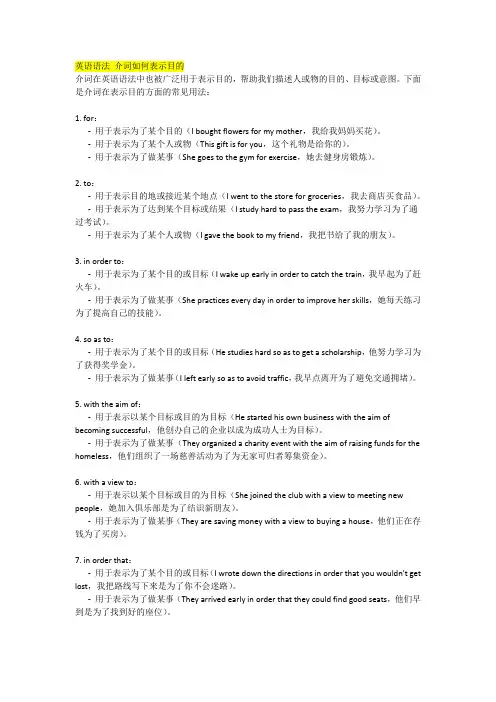
英语语法介词如何表示目的介词在英语语法中也被广泛用于表示目的,帮助我们描述人或物的目的、目标或意图。
下面是介词在表示目的方面的常见用法:1. for:-用于表示为了某个目的(I bought flowers for my mother,我给我妈妈买花)。
-用于表示为了某个人或物(This gift is for you,这个礼物是给你的)。
-用于表示为了做某事(She goes to the gym for exercise,她去健身房锻炼)。
2. to:-用于表示目的地或接近某个地点(I went to the store for groceries,我去商店买食品)。
-用于表示为了达到某个目标或结果(I study hard to pass the exam,我努力学习为了通过考试)。
-用于表示为了某个人或物(I gave the book to my friend,我把书给了我的朋友)。
3. in order to:-用于表示为了某个目的或目标(I wake up early in order to catch the train,我早起为了赶火车)。
-用于表示为了做某事(She practices every day in order to improve her skills,她每天练习为了提高自己的技能)。
4. so as to:-用于表示为了某个目的或目标(He studies hard so as to get a scholarship,他努力学习为了获得奖学金)。
-用于表示为了做某事(I left early so as to avoid traffic,我早点离开为了避免交通拥堵)。
5. with the aim of:-用于表示以某个目标或目的为目标(He started his own business with the aim of becoming successful,他创办自己的企业以成为成功人士为目标)。
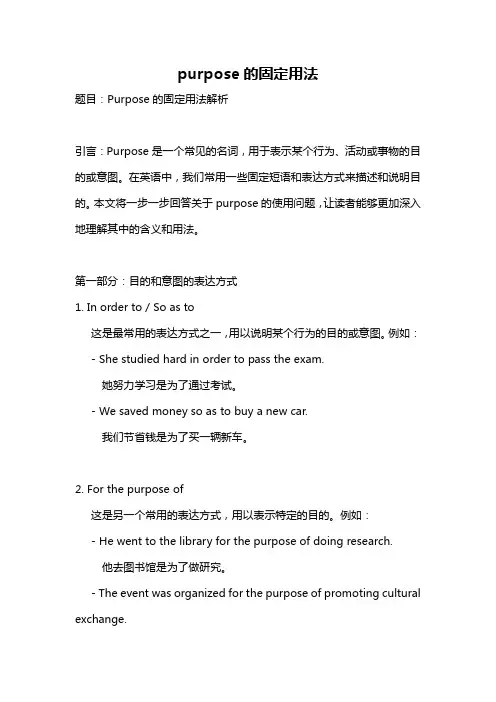
purpose的固定用法 题目:Purpose的固定用法解析
引言:Purpose是一个常见的名词,用于表示某个行为、活动或事物的目的或意图。在英语中,我们常用一些固定短语和表达方式来描述和说明目的。本文将一步一步回答关于purpose的使用问题,让读者能够更加深入地理解其中的含义和用法。
第一部分:目的和意图的表达方式 1. In order to / So as to 这是最常用的表达方式之一,用以说明某个行为的目的或意图。例如: - She studied hard in order to pass the exam. 她努力学习是为了通过考试。 - We saved money so as to buy a new car. 我们节省钱是为了买一辆新车。
2. For the purpose of 这是另一个常用的表达方式,用以表示特定的目的。例如: - He went to the library for the purpose of doing research. 他去图书馆是为了做研究。 - The event was organized for the purpose of promoting cultural exchange. 这个活动是为了促进文化交流而组织的。 3. With the aim/intention of 表示某个行为或活动的目的或意图。例如: - They started a charity organization with the aim of helping the homeless. 他们创建了一个慈善组织,以帮助无家可归者为目标。 - She took the job with the intention of gaining more experience. 她接受这份工作是为了获得更多经验。
第二部分:目的和意图的细分 1. Educational purpose 表示为了教育目的而进行的活动或使用的目的。例如: - The school organized a trip to the museum for educational purposes. 学校组织了一次去博物馆的旅行,以达到教育目的。 - The toys were designed with an educational purpose in mind. 这些玩具的设计初衷是教育目的。
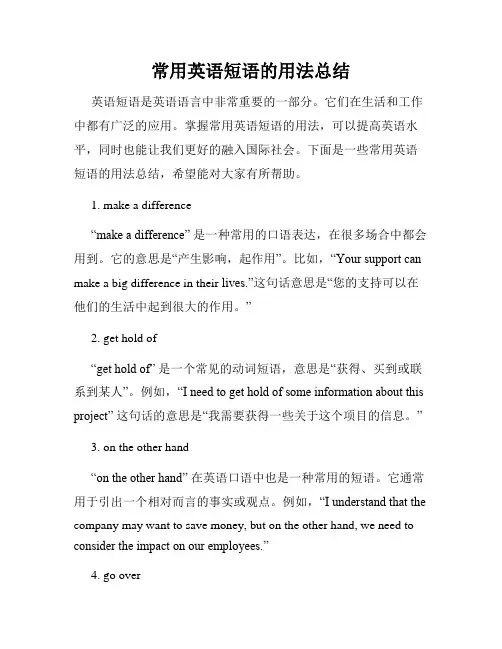
常用英语短语的用法总结英语短语是英语语言中非常重要的一部分。
它们在生活和工作中都有广泛的应用。
掌握常用英语短语的用法,可以提高英语水平,同时也能让我们更好的融入国际社会。
下面是一些常用英语短语的用法总结,希望能对大家有所帮助。
1. make a difference“make a difference” 是一种常用的口语表达,在很多场合中都会用到。
它的意思是“产生影响,起作用”。
比如,“Your support can make a big difference in their lives.”这句话意思是“您的支持可以在他们的生活中起到很大的作用。
”2. get hold of“get hold of” 是一个常见的动词短语,意思是“获得、买到或联系到某人”。
例如,“I need to get hold of some information about this project” 这句话的意思是“我需要获得一些关于这个项目的信息。
”3. on the other hand“on the other hand” 在英语口语中也是一种常用的短语。
它通常用于引出一个相对而言的事实或观点。
例如,“I understand that the company may want to save money, but on the other hand, we need to consider the impact on our employees.”4. go over“go over” 是一个常用的动词短语,意思是“检查,复习”。
例如,“Before you submit the report, please go over it one more time to make sur e there are no mistakes.”5. by the way“by the way” 是一种常见的短语,在口语和书面语中都可以使用。
![[英语语法] 介词to, at, on, in, from,...](https://uimg.taocdn.com/7a116922af45b307e8719779.webp)
一、介词to的常见用法1. 动词 toadjust to适应 attend to处理;照料agree to赞同 amount to加起来达…belong to属于 come to达到drink to为…干杯 get to到达happen to发生在某人身上 hold to紧握lead to通向 listen to听,occur to想起 object to反对,point to指向 respond to回答,refer to参考;指的是…;涉及 reply to回答,see to负责 stick to坚持,turn to求助2. 动词( sth.) to sb.announce to通知某人 describe to向某人描述explain to向某人解释 express to对某人表达mention to提及 nod to向某人点头report to报告 say to告知hout to对某人大叫 suggest to提建议speak to与某人交谈 talk to跟某人谈话whisper to和某人低声耳语3. 动词 sth./sb. to sth./sb.add to增加 compare to比作carry to运送至 devote to致力于introduce to介绍给 invite to邀请参加join to连接到 leave to委托给reduce to下降至 sentence to判处take to带到4. be 形容词/过去分词 tobe alive to觉察;晓得 be attentive to注意;留心be awake to知晓 be blind to缺乏眼光be close to紧挨着 be common to对...很普通be contrary to违反;反对 be devoted to致力be deaf to不愿意听 be equal to有…的力量be exposed to暴露;遭受 be fair to对…公平be familiar to对某人来说熟悉 be grateful to对...心存感激be good to对…有好处 be harmful to对…有危害be important to对…重要 be kind to友好对待be known to周知于 be married to嫁给be moved to转移到 be near to靠近be necessary to对…有必要 be opposite to在对面be opposed to反对 be pleasant to合某人之意be proper to专属 be polite to礼貌待人be rude to粗暴对待 be relative to与…有关be strange to不习惯 be similar to类似be suitable to适合 be true to忠实be thankful to感激 be useful to对…有用be used to习惯5. to 名词构成的词组to a degree在某种程度上 to date到现在为止to one’s feet跳起来 to one’s mind照…看来to one’s surprise使…吃惊 to one’s taste符合胃口to oneself独自享用 to order定做to the letter不折不扣地 qto the point中肯地二、at的常见用法1. 动词 atarrive at抵达 call at访问某地catch at(it)当场抓住 come at攻击fire at向…开火 glance at瞟一眼glare at怒目而视 grieve at忧伤knock at敲 laugh at嘲笑look at看一眼 pull at拉扯rejoice at对…高兴 smile at向某人微笑shoot at朝…射击 stare at怒目而视thrust at刺向 tear at撕tremble at颤抖 wonder at吃惊work at工作2. be 形容词/过去分词 atbe angry at恼怒于 be alarmed at对…保持警觉be astonished at对…吃惊 be bad at不擅长be clever at对某事很灵巧 be delighted at高兴be disgusted at厌恶 be disappointed at对…失望be good at擅长 be impatient at对…不够耐心be mad at狂热于 be pleased at对…感到高兴be present at出席 be satisfied at满意be surprised at吃惊 be shocked at对…非常震惊be terrified at受到…的恐吓 be quick at对…很机敏3.at 名词构成的词组at a distance在一定距离 at a loss不知所措at a time一次 at all一点也不at any cost不惜一切代价 at best最好也只是at first起初 at hand手头at heart在内心里 at home在家;无拘束at last最后 at least至少at most最多 at once马上at present目前。
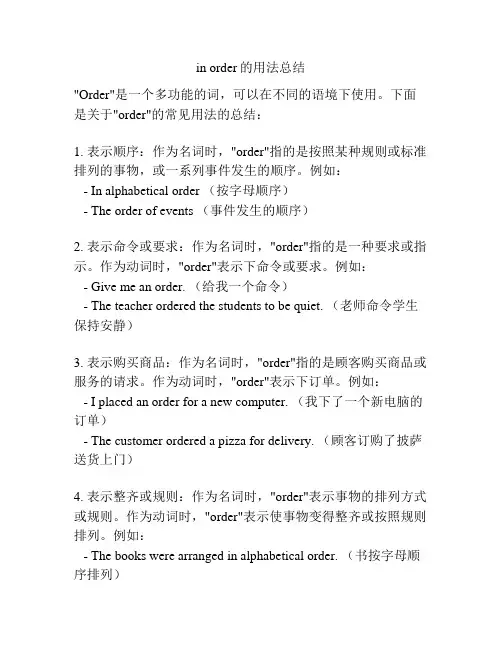
in order的用法总结"Order"是一个多功能的词,可以在不同的语境下使用。
下面是关于"order"的常见用法的总结:1. 表示顺序:作为名词时,"order"指的是按照某种规则或标准排列的事物,或一系列事件发生的顺序。
例如:- In alphabetical order (按字母顺序)- The order of events (事件发生的顺序)2. 表示命令或要求:作为名词时,"order"指的是一种要求或指示。
作为动词时,"order"表示下命令或要求。
例如:- Give me an order. (给我一个命令)- The teacher ordered the students to be quiet. (老师命令学生保持安静)3. 表示购买商品:作为名词时,"order"指的是顾客购买商品或服务的请求。
作为动词时,"order"表示下订单。
例如:- I placed an order for a new computer. (我下了一个新电脑的订单)- The customer ordered a pizza for delivery. (顾客订购了披萨送货上门)4. 表示整齐或规则:作为名词时,"order"表示事物的排列方式或规则。
作为动词时,"order"表示使事物变得整齐或按照规则排列。
例如:- The books were arranged in alphabetical order. (书按字母顺序排列)- She ordered her desk and files. (她整理了她的办公桌和文件)5. 表示组织或管理:作为名词时,"order"指的是某种组织或管理的方式。
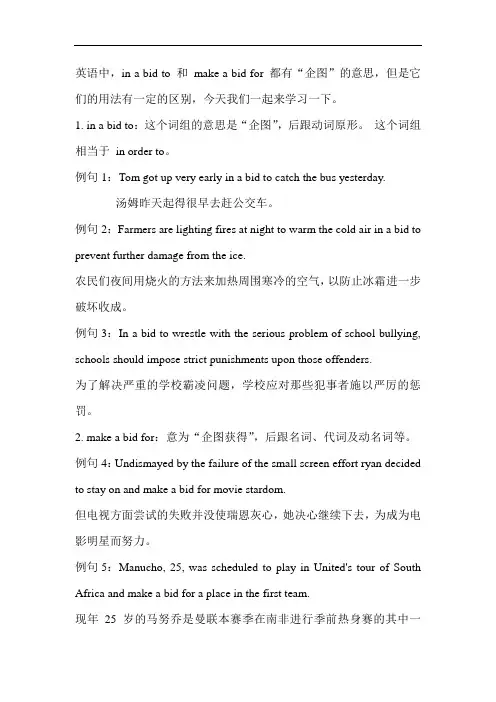
英语中,in a bid to 和make a bid for 都有“企图”的意思,但是它们的用法有一定的区别,今天我们一起来学习一下。
1. in a bid to:这个词组的意思是“企图”,后跟动词原形。
这个词组相当于in order to。
例句1:Tom got up very early in a bid to catch the bus yesterday.汤姆昨天起得很早去赶公交车。
例句2:Farmers are lighting fires at night to warm the cold air in a bid to prevent further damage from the ice.农民们夜间用烧火的方法来加热周围寒冷的空气,以防止冰霜进一步破坏收成。
例句3:In a bid to wrestle with the serious problem of school bullying, schools should impose strict punishments upon those offenders.为了解决严重的学校霸凌问题,学校应对那些犯事者施以严厉的惩罚。
2. make a bid for:意为“企图获得”,后跟名词、代词及动名词等。
例句4:Undismayed by the failure of the small screen effort ryan decided to stay on and make a bid for movie stardom.但电视方面尝试的失败并没使瑞恩灰心,她决心继续下去,为成为电影明星而努力。
例句5:Manucho, 25, was scheduled to play in United's tour of South Africa and make a bid for a place in the first team.现年25岁的马努乔是曼联本赛季在南非进行季前热身赛的其中一员,他也将为曼联一线队的位置而进行奋斗。
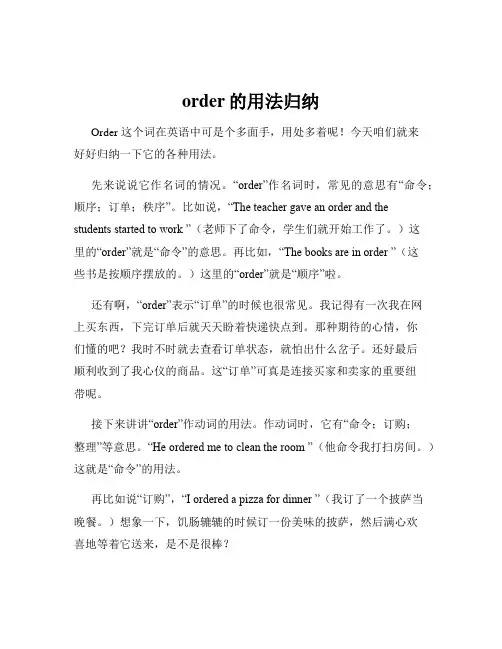
order的用法归纳Order 这个词在英语中可是个多面手,用处多着呢!今天咱们就来好好归纳一下它的各种用法。
先来说说它作名词的情况。
“order”作名词时,常见的意思有“命令;顺序;订单;秩序”。
比如说,“The teacher gave an order and the students started to work ”(老师下了命令,学生们就开始工作了。
)这里的“order”就是“命令”的意思。
再比如,“The books are in order ”(这些书是按顺序摆放的。
)这里的“order”就是“顺序”啦。
还有啊,“order”表示“订单”的时候也很常见。
我记得有一次我在网上买东西,下完订单后就天天盼着快递快点到。
那种期待的心情,你们懂的吧?我时不时就去查看订单状态,就怕出什么岔子。
还好最后顺利收到了我心仪的商品。
这“订单”可真是连接买家和卖家的重要纽带呢。
接下来讲讲“order”作动词的用法。
作动词时,它有“命令;订购;整理”等意思。
“He ordered me to clean the room ”(他命令我打扫房间。
)这就是“命令”的用法。
再比如说“订购”,“I ordered a pizza for dinner ”(我订了一个披萨当晚餐。
)想象一下,饥肠辘辘的时候订一份美味的披萨,然后满心欢喜地等着它送来,是不是很棒?“整理”这个意思也实用,“She ordered her desk before leaving ”(她在离开前整理了一下桌子。
)把东西整理得井井有条,心情都会变好呢。
“in order to”这个短语大家也要注意哦,它表示“为了”。
比如说,“He studies hard in order to get good grades ”(他努力学习为了取得好成绩。
)还有“out of order”,意思是“出故障;秩序混乱”。
就像有一次我去坐电梯,结果电梯显示“out of order”,可把我急坏了,只能爬楼梯,累得气喘吁吁。
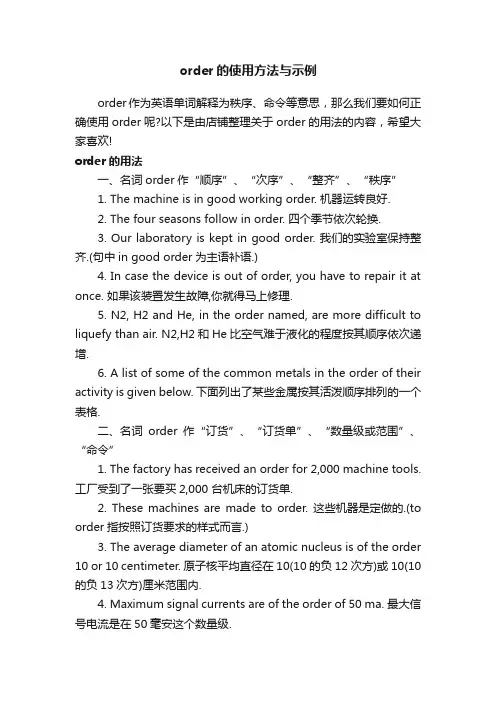
order的使用方法与示例order作为英语单词解释为秩序、命令等意思,那么我们要如何正确使用order呢?以下是由店铺整理关于order的用法的内容,希望大家喜欢!order的用法一、名词order作“顺序”、“次序”、“整齐”、“秩序”1. The machine is in good working order. 机器运转良好.2. The four seasons follow in order. 四个季节依次轮换.3. Our laboratory is kept in good order. 我们的实验室保持整齐.(句中in good order为主语补语.)4. In case the device is out of order, you have to repair it at once. 如果该装置发生故障,你就得马上修理.5. N2, H2 and He, in the order named, are more difficult to liquefy than air. N2,H2和He比空气难于液化的程度按其顺序依次递增.6. A list of some of the common metals in the order of their activity is given below. 下面列出了某些金属按其活泼顺序排列的一个表格.二、名词order作“订货”、“订货单”、“数量级或范围”、“命令”1. The factory has received an order for 2,000 machine tools. 工厂受到了一张要买2,000 台机床的订货单.2. These machines are made to order. 这些机器是定做的.(to order指按照订货要求的样式而言.)3. The average diameter of an atomic nucleus is of the order 10 or 10 centimeter. 原子核平均直径在10(10的负12次方)或10(10的负13次方)厘米范围内.4. Maximum signal currents are of the order of 50 ma. 最大信号电流是在50毫安这个数量级.5. He gave orders for the work to be started. (=…orders that the work should be started.)他下令开始工作.三、用“in order+带to的不定式”表示目的状语:1. We are working hard (in order) to build socialism in China. 我们正在为中国建设社会主义而努力工作.2. In order to measure the resistance of a conductor, it is necessary to have some fixed standard. 为了测量导体的电阻,就要有某种固定的标准.3. They took off their shoes upon (on) entering, in order not to soil the mats. 他们进来时都脱鞋,免得弄脏地毯.4. In order to adjust the level, we may screw the bolt up or down. 我们上下拧动螺钉以调节该水平仪.注1:有时可省略in order,而直接用不定式表示目的状语:We have produced a lot of tractors (in order) to meet the needs of our agriculture.我们生产了许多拖拉机以满足我们农业的需要.(In order) To understand these uses, you must know some of the properties of oxygen.要了解这些用途,你必须知道氧的某些性质.注2:注意in order后面出现不定式的逻辑主义for…的情况:In order for two forces to neutralize each other, they must act on the same object.为了使两个力互相抵消,它们必须作用于同一物体上.注3:若用“on purpose+不定式”代替“in order +不定式”,则前者含有特地、故意意味而使目的的状语语气加强.例如:She has left this tool on purpose for you to use.她有意把这个工具留在这里让出使用.四、用“in order that”引导目的从句:1. What is needed in order that electrical charges may moves? 需要什么才能使电荷运动呢?2. In order that work can be done, in scientific sense, a forcemust move an object through some distance. 就科学意义来说,为了做功,力必须推动物体通过一定距离.3. You must knock down the machines before shipping in order that they shall arrive in good shape. 你们必须在装运前拆卸这些机器以使他们完整无损到达.4. The old worker, in order that there might be no time lost, oiled the machines himself. 为节省时间,老工人亲自给机器上油.注:在in order that引出的目的状语从句内,常用情态动词may,might,can,could,shall等.当目的的状语从句在句末时,还常可用so that或to the end that代替in order that.五、动词order作“定制”、“订购”、“命令”1. They have ordered 1,000 oil pumps from our factory.他们已向我厂订购1,000台油泵.2. The doctor ordered him to stay there.医生嘱咐他留在那里.(不定式短语to stay there作宾语补语)order的释义英 [ˈɔ:də(r)] 美 [ˈɔ:rdə(r)]n.秩序; 命令; 次序; 规则,制度vt.命令; 订购; 整理vi.下订单order的示例Most schools are extremely unwilling to cut down on staff in order to cut costs.大部分学校都很不愿意为减少开支而裁员。
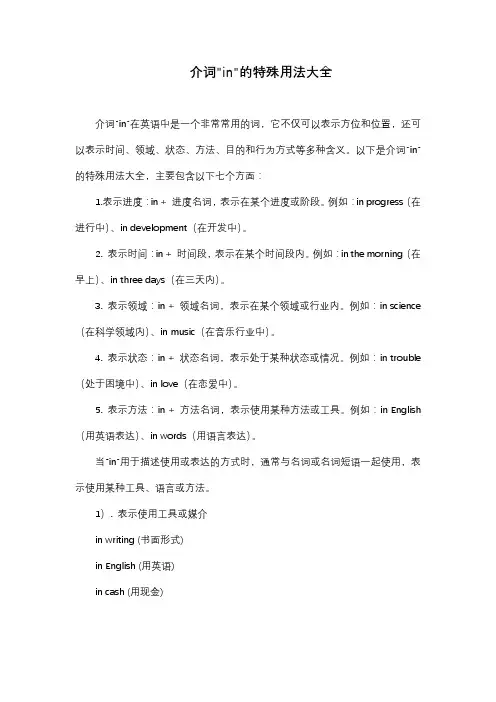
介词"in"的特殊用法大全介词"in"在英语中是一个非常常用的词,它不仅可以表示方位和位置,还可以表示时间、领域、状态、方法、目的和行为方式等多种含义。
以下是介词"in"的特殊用法大全,主要包含以下七个方面:1.表示进度:in + 进度名词,表示在某个进度或阶段。
例如:in progress(在进行中)、in development(在开发中)。
2. 表示时间:in + 时间段,表示在某个时间段内。
例如:in the morning(在早上)、in three days(在三天内)。
3. 表示领域:in + 领域名词,表示在某个领域或行业内。
例如:in science (在科学领域内)、in music(在音乐行业中)。
4. 表示状态:in + 状态名词,表示处于某种状态或情况。
例如:in trouble (处于困境中)、in love(在恋爱中)。
5. 表示方法:in + 方法名词,表示使用某种方法或工具。
例如:in English (用英语表达)、in words(用语言表达)。
当“in”用于描述使用或表达的方式时,通常与名词或名词短语一起使用,表示使用某种工具、语言或方法。
1). 表示使用工具或媒介in writing (书面形式)in English (用英语)in cash (用现金)2). 表示表达方式in words (用语言表达)in simple terms (简而言之)in detail (详细地)3.)表示艺术形式或风格in poetry (以诗歌的形式)in prose (以散文的形式)in paint (以绘画的形式)4). 表示方法或手段in this way (以这种方式)in the modern sense (按照现代的意义)in a unique style (以独特的风格)5). 固定搭配除了上述用法,还有一些固定搭配,如“in public”(在公共场合)、“in private”(私下地)等。
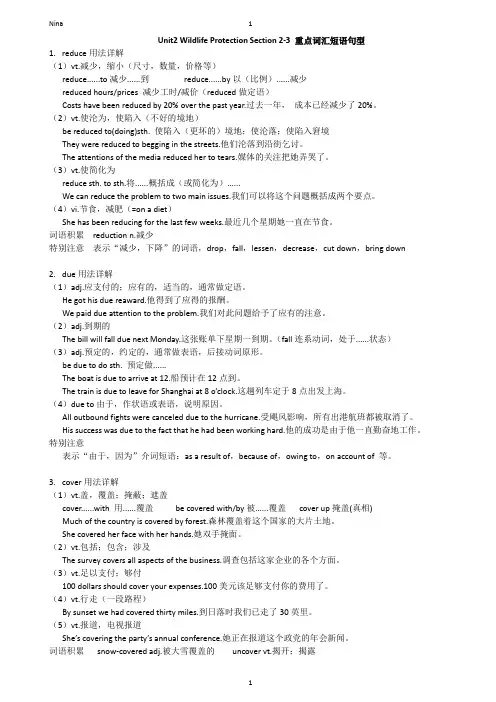
Unit2 Wildlife Protection Section 2-3 重点词汇短语句型1.reduce用法详解(1)vt.减少,缩小(尺寸,数量,价格等)reduce......to减少......到reduce......by以(比例)......减少reduced hours/prices 减少工时/减价(reduced做定语)Costs have been reduced by 20% over the past year.过去一年,成本已经减少了20%。
(2)vt.使沦为,使陷入(不好的境地)be reduced to(doing)sth. 使陷入(更坏的)境地;使沦落;使陷入窘境They were reduced to begging in the streets.他们沦落到沿街乞讨。
The attentions of the media reduced her to tears.媒体的关注把她弄哭了。
(3)vt.使简化为reduce sth. to sth.将......概括成(或简化为)......We can reduce the problem to two main issues.我们可以将这个问题概括成两个要点。
(4)vi.节食,减肥(=on a diet)She has been reducing for the last few weeks.最近几个星期她一直在节食。
词语积累reduction n.减少特别注意表示“减少,下降”的词语,drop,fall,lessen,decrease,cut down,bring down2.due用法详解(1)adj.应支付的;应有的,适当的,通常做定语。
He got his due reaward.他得到了应得的报酬。
We paid due attention to the problem.我们对此问题给予了应有的注意。
(2)adj.到期的The bill will fall due next Monday.这张账单下星期一到期。
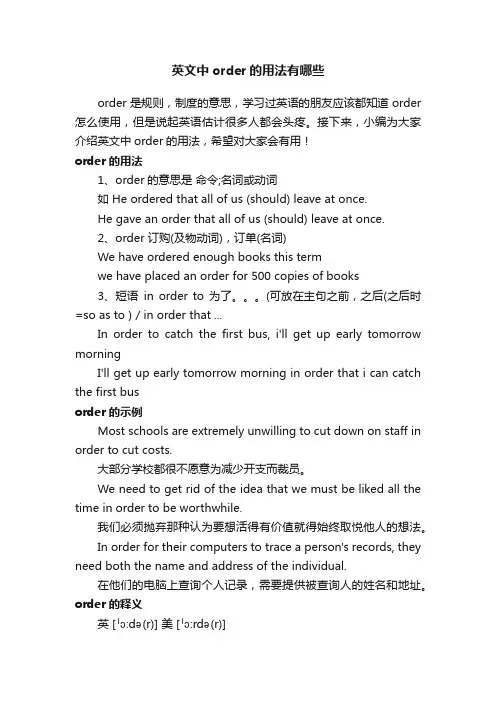
英文中order的用法有哪些order是规则,制度的意思,学习过英语的朋友应该都知道order 怎么使用,但是说起英语估计很多人都会头疼。
接下来,小编为大家介绍英文中order的用法,希望对大家会有用!order的用法1、order的意思是命令;名词或动词如 He ordered that all of us (should) leave at once.He gave an order that all of us (should) leave at once.2、order 订购(及物动词),订单(名词)We have ordered enough books this termwe have placed an order for 500 copies of books3、短语in order to 为了。
(可放在主句之前,之后(之后时=so as to ) / in order that ...In order to catch the first bus, i'll get up early tomorrow morningI'll get up early tomorrow morning in order that i can catch the first busorder的示例Most schools are extremely unwilling to cut down on staff in order to cut costs.大部分学校都很不愿意为减少开支而裁员。
We need to get rid of the idea that we must be liked all the time in order to be worthwhile.我们必须抛弃那种认为要想活得有价值就得始终取悦他人的想法。
In order for their computers to trace a person's records, they need both the name and address of the individual.在他们的电脑上查询个人记录,需要提供被查询人的姓名和地址。
目的状语从句的引导词及句型目的状语从句是指在一个主句中,用来表达一个动作或目的的从句。
在汉语中,我们常常使用目的状语从句来表达一个行动、目标或目的。
而在英语中,我们需要使用特定的引导词和句型来构建目的状语从句。
本文将介绍目的状语从句的引导词及句型,以帮助读者更好地理解和运用。
一、引导词以下是常用的引导词,它们可用于引导目的状语从句:1. so that:意为“为了”,常常用于句子中的目的状语从句,也可以放在句子的末尾。
例如:I study hard so that I can get good grades.2. in order that:与so that的意思相近,也常常用于句子中的目的状语从句。
例如:I saved money in order that I could buy a new car.3. to:常用于句子中的目的状语从句,也可放在句子中的末尾。
例如:She went to bed early to get enough rest.4. in case:意为“以防”,用于表示某个动作或行为为了避免事物发生的目的。
例如:I brought an umbrella in case it rains.5. for fear that:意为“害怕”,用于表示因害怕某种结果而采取行动的目的。
例如:He locked the door for fear that someone would steal his belongings.二、句型除了以上的引导词,目的状语从句还可以使用其他句型来表达目的。
以下是常见的几种句型:1. in order to do something:这种句型常常用于主句中,表达为了达到某种目的而进行的行动。
例如:He took the job in order to earn more money.2. so as to do something:与in order to类似,表达为了达到某种目的而进行的行动。
order的用法和短语例句order有命令;定购;调整;整理;点餐;预定,订货等意思,那么你知道order的用法吗?下面跟着店铺一起来学习一下,希望对大家的学习有所帮助!order的用法大全:order的用法1:order作“次序,顺序”“治安,秩序”“整齐,有条理”解时,是不可数名词。
作“订购,订货”“命令,嘱咐”“汇票,汇单”解时,是可数名词。
order的用法2:order的复数形式orders可指一条命令,可接动词不定式或that从句作定语,也可接that从句,中心谓语动词要用虚拟式。
order的用法3:order在表示“勋章”时,要带定冠词the,order 的第一个字母要大写,其后接of。
order的用法4:order作“…级”“种类”“方式”等解时是可数名词。
order的用法5:peace and order的意思是“和平和秩序”,指的是“治安情况”。
在与no连用时表示“治安情况极差”。
order的用法6:in order可作“有条有理”“整齐”“情况正常”解,在句中作表语或补语。
out of order的意思是“(机器)坏了”“(身体)有病了”“不妥当”“违反会议规程”等。
order的用法7:in order to的意思是“以…为目的”,在句中作状语,后接动词原形; 而in order that的意思是“以便”“以至于”,在句中引导状语从句。
order的用法8:order用作动词时的基本意思是“命令”“建立秩序”,即命令某人去某地或做某事,引申可表示为“整理”“布置”,即消除不和谐与混乱,或接受严格的纪律、秩序。
order还可表示“签订订单”“订购”“预订用餐”等。
order的用法9:order是及物动词,接名词、代词、虚拟的that 从句作宾语,也可接双宾语,其间接宾语可以转化为介词for的宾语,还可接形容词、副词、介词短语、过去分词、动词不定式、that从句作补足语的复合宾语。
初一英语目的状语从句in order to 和so as to 区别单选题30题6.She gets up early in the morning in order to/so as to catch the school bus on time.(“in order to”和“so as to”可以互换)A.in order toB.so as toC.both A and BD.neither A nor B答案:C。
本题中“in order to”和“so as to”都可以用来表示目的,意为“为了”,在这个语境下可以互换,所以答案是C。
7.The students study hard in order to/so as to get good grades.(“in order to”和“so as to”可以互换)A.in order toB.so as toC.both A and BD.neither A nor B答案:C。
“in order to”和“so as to”在这里都表示目的“为了”,二者可互换,答案为C。
8.He does extra exercises in order to/so as to improve his English.((“in order to”和“so as to”可以互换)A.in order toB.so as toC.both A and BD.neither A nor B答案:C。
“in order to”和“so as to”都是为了表示目的,在这个句子中意思相同,可以互换,答案是C。
9.She reads many books in order to/so as to widen her knowledge.(“in order to”和“so as to”可以互换)A.in order toB.so as toC.both A and BD.neither A nor B答案:C。
ordered用法搭配
下面是几种常见的"ordered"的用法搭配:
1. order something: 下订单某物
- I ordered a new book from an online bookstore.
- 我在网上书店订购了一本新书。
2. order from: 从...订购
- We usually order our supplies from a local supplier.
- 我们通常从当地供应商订购我们的物资。
3. in order: 为了;以便
- I need to finish this report by Friday in order to meet the deadline.
- 我需要在周五前完成这份报告,以便赶上截止日期。
4. in the order of: 按...的顺序
- The planets in our solar system are arranged in the order of their distance from the sun. - 我们太阳系中的行星按照离太阳的距离排列。
5. chronological order: 按时间顺序
- The events in the history book are presented in chronological order.
- 历史书中的事件按照时间顺序呈现。
6. place an order: 下订单
- I need to place an order for more office supplies.
- 我需要下订单订购更多的办公用品。
介宾用法表示目的原因结果等关系介宾用法是英语中一种常见的句子结构,用于表示目的、原因、结果等关系。
本文将详细介绍介宾用法的定义、用法和相关例子。
一、介宾用法的定义介宾用法是指使用介词加名词、代词或动名词短语作为宾语的句子结构。
介词起到连接词组和其他部分的作用,同时表达宾语与前文之间的关系,如目的、原因、结果等。
二、介宾用法表示目的1. 介宾用法表示目的的常见介词包括:to, for, in order to等。
2. 介宾用法表示目的的常见句型:- "I went to the bookstore to buy a new book."- "She studied hard in order to pass the exam."- "He works overtime for his family's well-being."三、介宾用法表示原因1. 介宾用法表示原因的常见介词包括:because of, due to, owing to 等。
2. 介宾用法表示原因的常见句型:- "She missed the bus because of the heavy traffic."- "Due to the bad weather, the football match was postponed."- "Owing to his hard work, he got promoted."四、介宾用法表示结果1. 介宾用法表示结果的常见介词包括:result in, lead to, cause等。
2. 介宾用法表示结果的常见句型:- "His laziness led to his failure in the exam."- "Smoking can result in serious health problems."- "The heavy rain caused flooding in the town."五、其他相关用法除了表示目的、原因、结果外,介宾用法还可以表示其他关系,如方式、条件等。
in order to
[观察]
1. He got up very early in order to / so as to catch the first bus.
2. In order to catch the first bus, he got up very early.
3. He works very hard in order to / so as to support his family.
4. Turn the volume down in order not to / so as not to wake the child.
[归纳] in order to 意为 “为了……”,表示目的;在用法和意义上相当于so as to
结构,但是in order to结构可以用于句首、句中,而so as to多用于句中。其否
定式分别为:in order not to 和so as not to。
[拓展] in order to和so as to在句中表示目的时,常可以转化成in order that或so
that引导的目的状语从句。如:
We should work hard in order to / so as to pass the exam.
→ We should work hard in order that / so that we can pass the exam.
为了能通过考试,我们应该努力学习。
[小试] 翻译下面的句子。
1. He went there early so as to / in order to get a good seat.
He went there early so that / in order that he could get a good seat.
2. In order not to wake the baby we went in quietly.
Key:
1. 他去得早,以便找到个好座位。
2. 为了不惊醒小孩,我们轻轻地走了进去。